| |
|
These new ruby deposits have rapidly become famous among gem dealers that supplied large quantity of ruby material into the Thaimarket. Many Thai gem traders have also ventured into the area. However, due to new regulations and limitations for gem trading and exporting from Mozambique, the Thai Sub-Committee for Gem Material Searching and International Relationship (appointed recently by the Ministry of Commerce) decided to pay a visit
to the Pemba and Montepuez in Cabo Delgado, Northern Mozambique (Figure 2) during September 22-24, 2009.
Dr.Chakkapant Suthirat, a GIT representative, also joined this mission. Discussions and negotiations with provincial authorities went well; besides, our mission had a chance to visit the potential area of Montepuez ruby deposit. The area covers over 100 km2 and occupies mostly flat plain and some updulating terrain (Figures 3 and 4). Unfortunately during our visit, the mining area was closed for visitors because it was still on the officially zoning process for mining concession. As such, we were not allowed to closely access the mine site. Mr. Fernando Thomas Natal, the District Governor, informed us that many Tanzanian gem miners and traders have moved into the mining area |
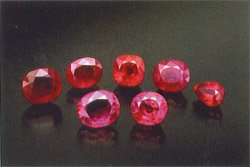 |
GIT's collection of Mozambique ruby. Front row:Unheated, 2.22 ct & 2.32 ct. Back row: heat-treated, from 1.12 ct-2.57 ct. reportedly came from the area in the northern part of Mozambique (Photograph by Wimon Manorotkul) |
|
|
Since the begining of 2009, GIT-GTL has received a number of stones called "Mozambique ruby" from gem dealers for certification. The stones reportedly came from the area in the northern part of Mozambique (Figure 1) and have been mined from two main areas, the Lichinga deposit, and the Montepuez deposit in the eastern part. The Lichinga deposit is located in the Niassa Province and has been mined earlier since December 2008. Most of the gem materials from this area were brought across the Tanzanian border and traded in Songea. Not before May of June 2009 most gem miners have moved eastwards and started mining in the area of Montepuez deposit of Cabo Delgado Province. |
|
| |
|
|
 |
Map of northern Mozambique showing locations of Lichinga in Niassa Province & Montapue3 in Cabo Delgado Province |
|
|
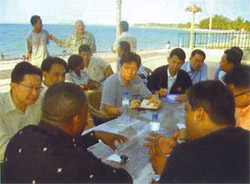 |
Discussion among the Thai sub-committee, Thai gem traders, & Mozambique government officers in Pemba |
|
| |
|
|
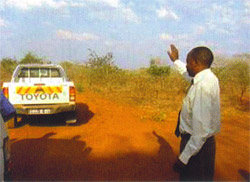 |
Over 100 km2 of this area may supply huge quanity of ruby for a long peroid of time. However, geological exploration has not yet been done prior to evaluation |
|
|
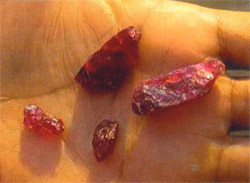 |
Montepuez rubies found in the local market showing beautiful color equivalent to those of Burmese ruby |
|
| |
|
|
and lived around Nanhupo market. That situation had created many problems, and led the officials to impose a new zoning regulation.
During our visit we witnessed loads of rough ruby available at local markets, at Nanhupo and at Montepuez Township. These rubies have a wide range of quality (Figures 5 and 6). As expected, top quality stones are rarely found; most of them require some quality enhancements. We were told that some traders also carried stones to Pemba for trading with Thai traders.
Based on our gemological data collected recently from the stones claimed to be the Mozambique ruby, there are a few untreated stones, some traditionally flux-assisted heated stones (similar to previous heated Burmese rubies) and also some lead-glass treated stones. The lead-bearing glass was introduced into open fractures of ruby by low temperature heating process and due to the high refractive index of lead glass; those fractures are masked or less visible.
A couple spectacular specimens of Montepuez ruby were presented by Thai gem traders during our visit. The first piece (over 15 cm long) is a large ruby assemblage with Some green amphibole (identified as actinolite by Raman technique) and white feldspar (Figure 7).
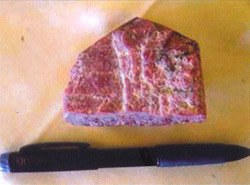 |
A large single crystal of ruby showing about two-thirds of its complete hexagonal form |
Microscopic investigation usually reveals dominant
lamella twining planes with cracks and mineral inclusions
which are identified particularly as amphibole, plagioclase
(anorthite) and rutile (Figure 9). Although these stones may
appear Similar to those of Burmese rubies, their mineral
inclusions and chemical finger prints are somehow different. Based on GIT's database, we can differentiate them
from metamorphic rubies from other major deposits (Figure 11). |
xx |
The other one is a large single crystal of ruby (about 7 cm in diameter; Figure 8). and being used for our ongoing research (Figure 6). Preliminary results show that they range in color from purplish red to red, some may contain dark patches which look similar to those of Burmese ruby from Mong Hsu (Figures 4 and 5). All of the stones show moderate red luminescence in LWUV and weak red in SWUV.
|
| |
 |
Some ruby samples were collected for our ongoing research at GIT mostly reveal well-shaped tabular hexagonal crystals |
|
| |
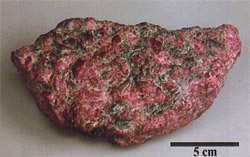 |
Huge ruby assemblage with green amphihole (actinolite) & white feldspar found within the Montepuez deposit; Mr. Thanayot Sodsri kindly donated this specimen to the Gem Museum of GIT |
|
| |
More details of Mozambique rubies from these new deposits will be carried out and placed on our website soon.
Apart from ruby, Mozambique is still very interesting for other resources such as tourism, seafood and timber. Long beautiful beaches, and good quality seafood within the country are waiting for your visit and investment.
Finally, it is very promising that Mozambique will supply
good quality ruby into the world gems market.
The services are provided by GIT include analyzing, testing and cerfifying all types of gemstones, in particular ruby and sapphire. GIT also examines the varieties of gemstones, distinguishing natural and synthetic counterparts, identifying quality enhancement methods, and determining the country of origin of ruby, sapphire, and emerald by professional gemologists.
|
 |
|
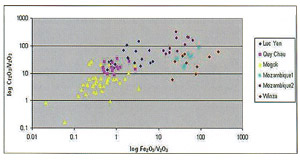 |
| Left - A number of mineral inclusions are usually observed in the Montepuez rubies. Right - Montepuez ruby commonly contains many cracks or fractures |
|
Chemical fingerprints obtained from different metamorphic rubies from various deposits, i.e., Luc Yen & Quy Chau from Vietnam, Mogok from Burma, Lichinga (Mozambique2) & Montepue3 (Mozambique2), & Winza from Tanzania. |
GIT Gem Testing Laboratory (GIT-GTL)
The Gem and Jewelry Institute Of Thailand (Public Organization)
www.git.or.th |
| |
|
|



